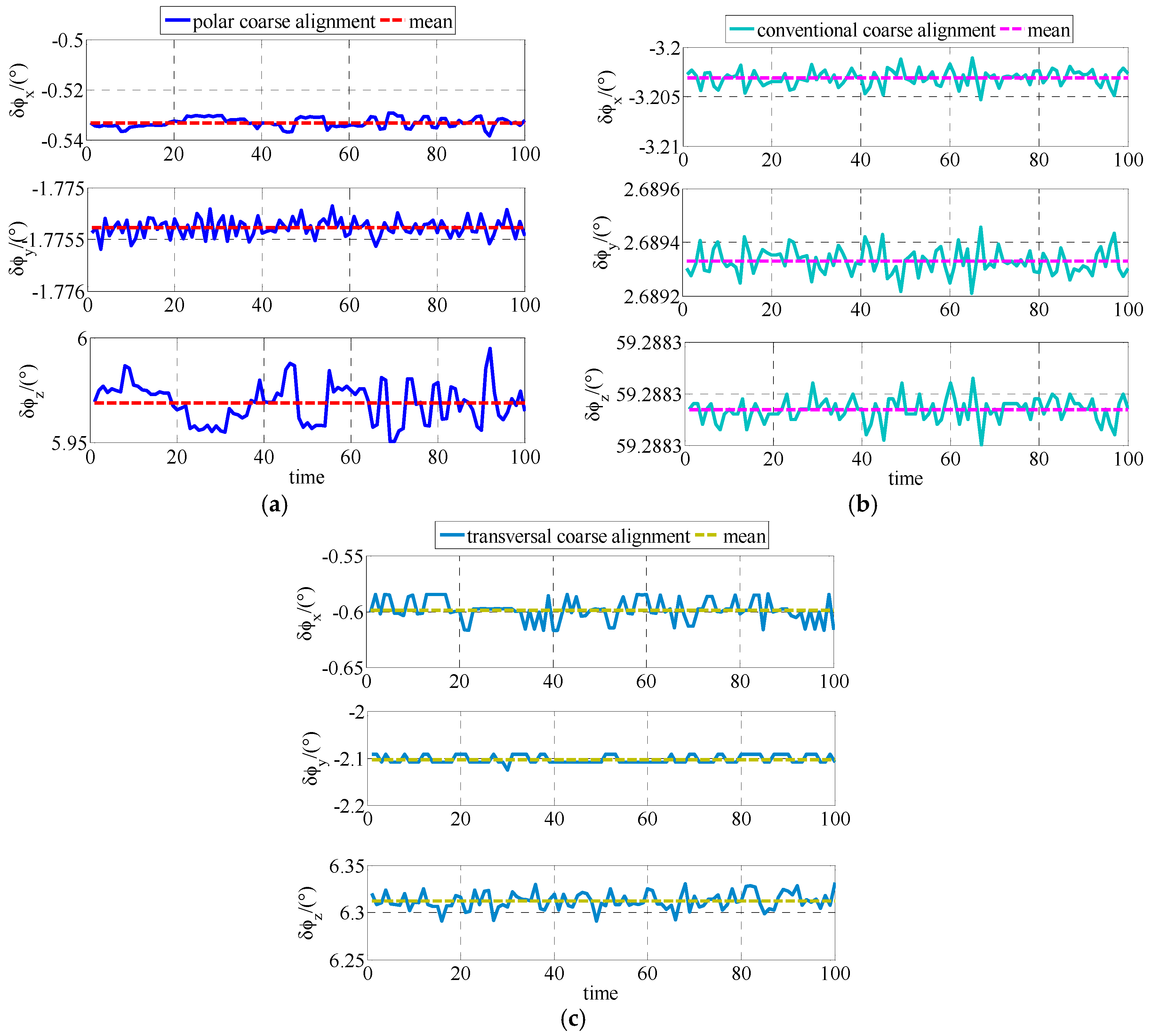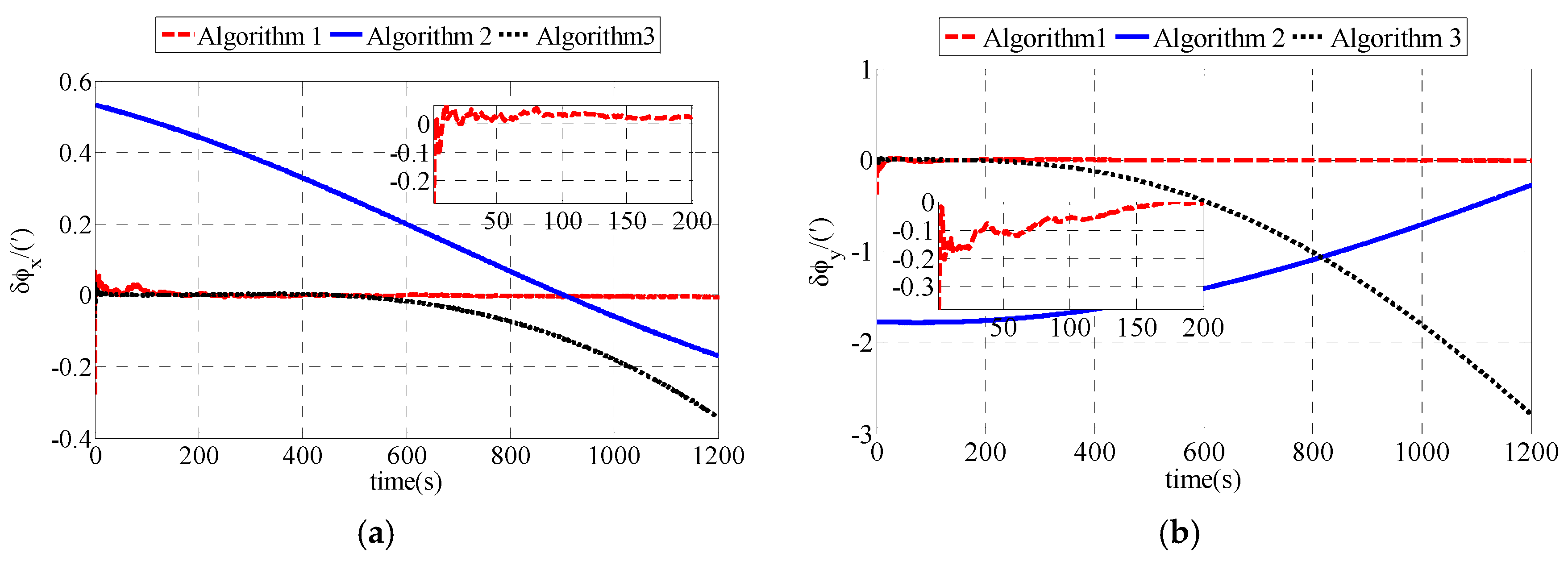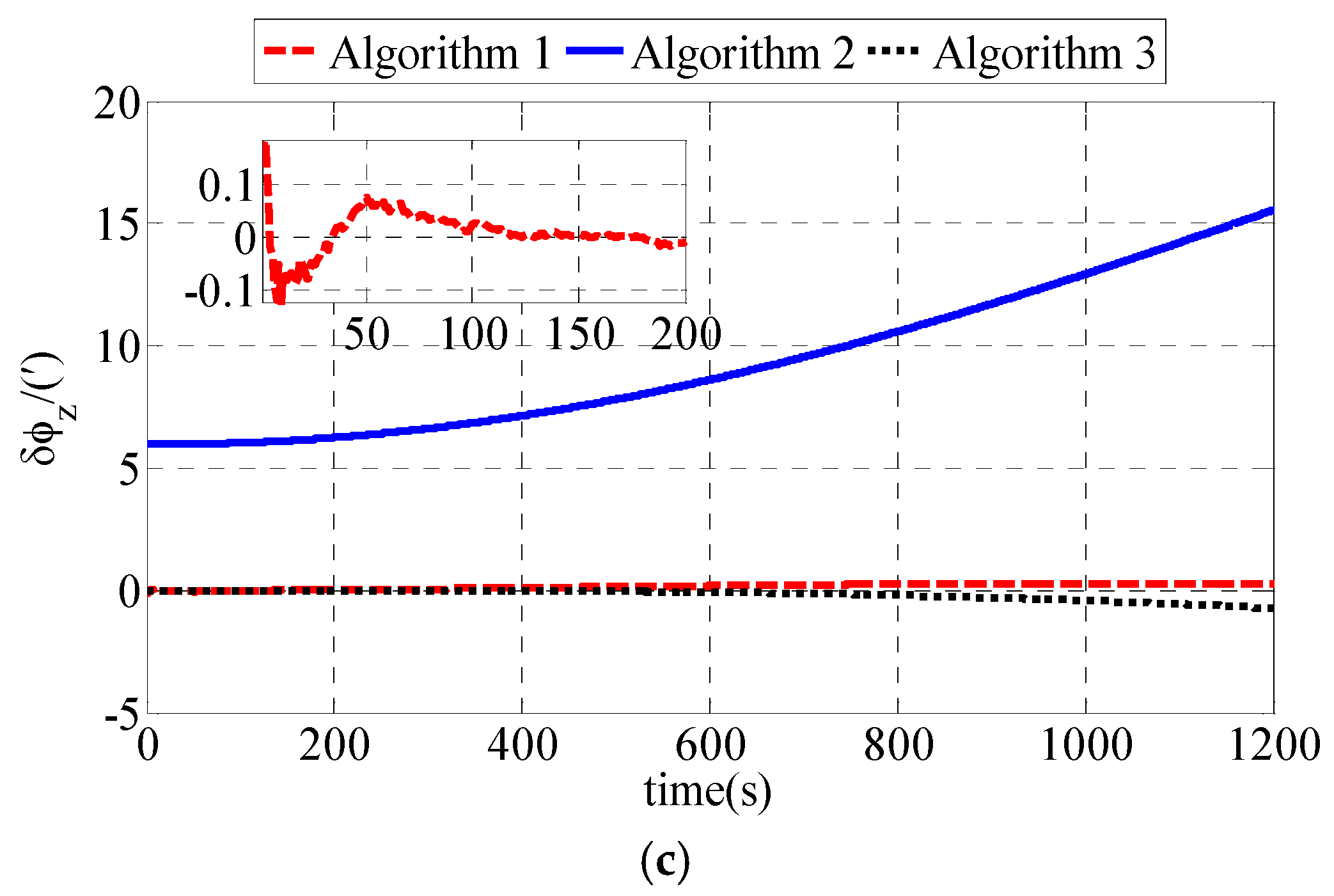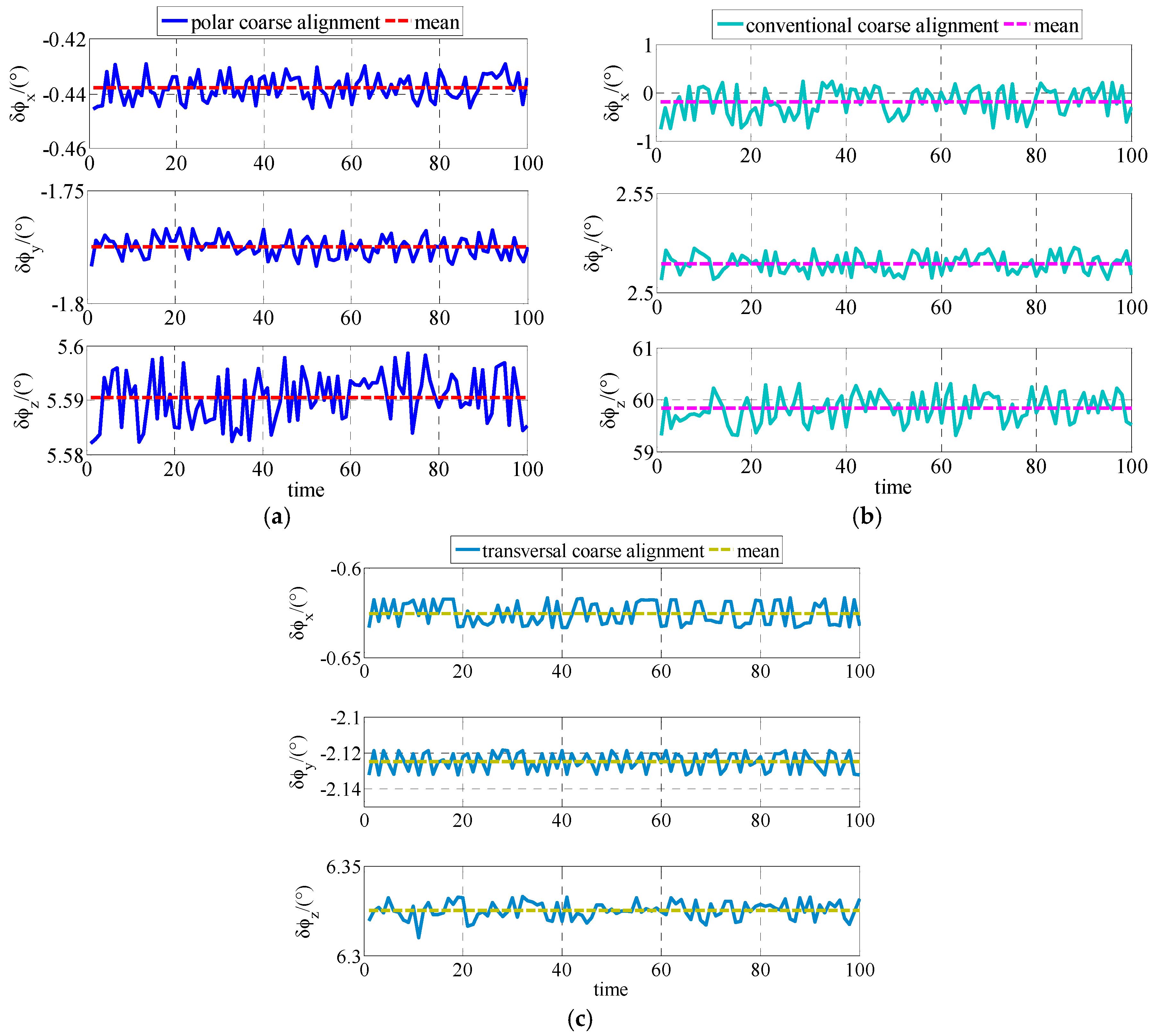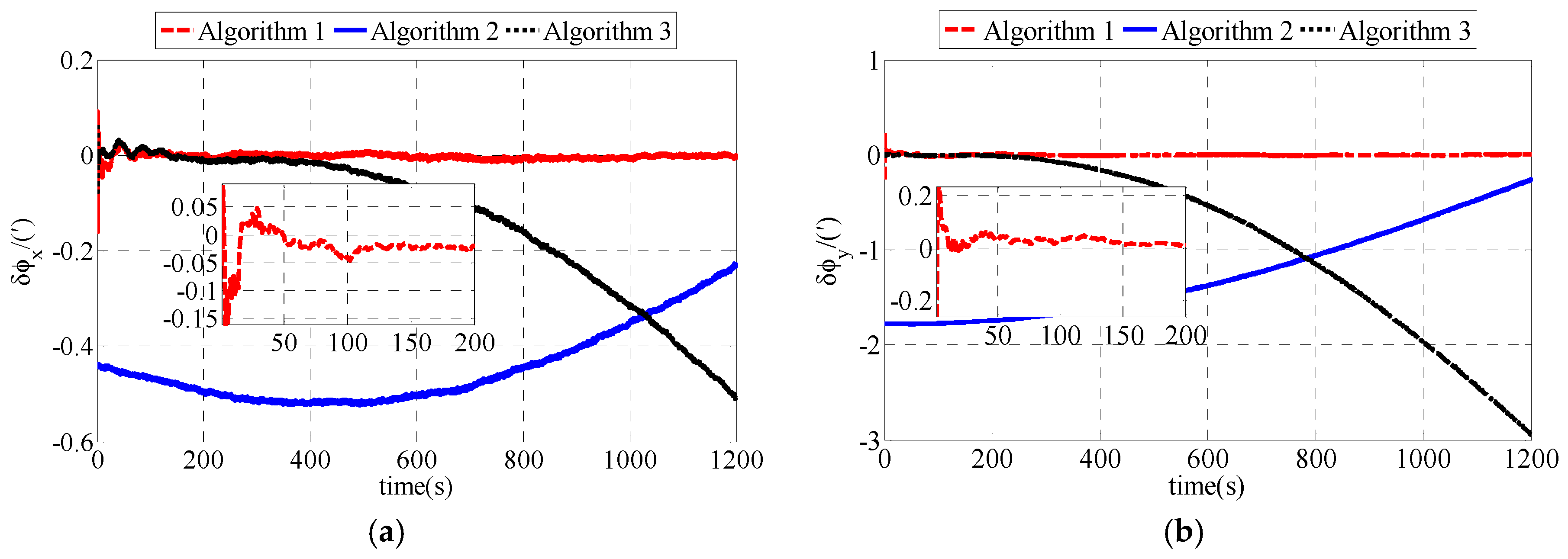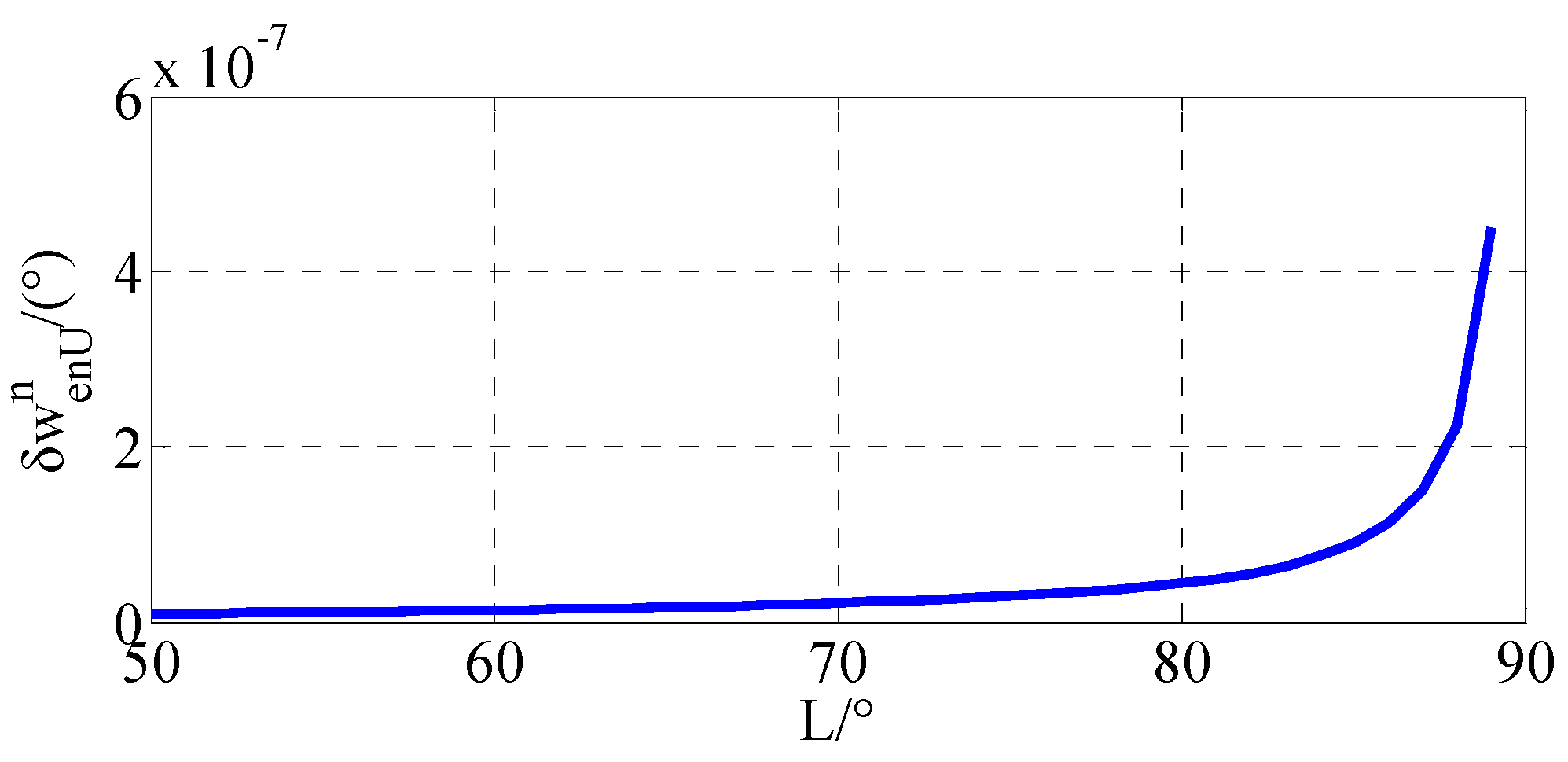1. Introduction
In recent years, the development of unmanned underwater vehicles (UUVs) has accelerated notably. UUVs play important roles in many aspects [
1,
2]. UUVs can accomplish missions in harsh environments, for example, the polar region. Strapdown inertial navigation systems (SINSs) are widely used in UUVs both in the polar region and in non-polar regions since they are highly autonomous [
3]. A SINS is essentially a process of recursive calculation under some initial conditions. It is based on the output of inertial measurement units (IMUs) that consists of gyroscopes and accelerometers. Initial alignment is crucial because the initial alignment results will be used as the initial SINS value, which might affect the subsequent SINS results [
4,
5]. The initial position and initial velocity can be obtained with the help of external auxiliary information. The main task of initial alignment is to determine the accurate initial attitude matrix. Initial alignment of SINS in UUV is intended to determine the initial attitude matrix in a short time with certain accuracy [
6]. Global navigation satellite systems, such as Global Position System (GPS), GLONASS, Galileo and Compass can provide an accurate reference position. A Doppler Velocity Log (DVL) can provide an accurate reference velocity. Therefore, the initial position and initial velocity can be easily determined. Especially for a temporarily anchored UUV in the polar region considered in this paper, the initial velocity is zero. To simplify the analysis and for the purposes of this paper, the initial position and initial velocity are assumed to be well provided. This polar initial alignment algorithm mainly focuses on the determination of the initial attitude of UUV in the polar region. There are two important indicators to measure the performance of an initial alignment algorithm, which are alignment accuracy and alignment speed [
7]. It is our goal to complete the initial alignment rapidly and accurately. Based on the motion characteristics of the base, initial alignments can be categorized into three types: the stationary base, the rocking base and the moving base. In the process of initial alignment, UUV is interfered by ocean waves. The IMU output contains this interference error. Bigger waves will result in more serious interference errors and lower signal-to noise ratios, making it difficult to extract useful information. According to the characteristics of the temporary anchoring UUV in the polar region, the initial UUV alignment corresponds to the rocking base type. Polar coarse alignment process and polar fine alignment process constitute a complete polar initial alignment process [
8,
9].
The coarse alignment process focuses on the requirements of the alignment speed. The initial attitude matrix must be determined as soon as possible and the initial misalignment angle is limited within a certain range. Many coarse alignment algorithms have been proposed for the non-polar region such as analytic coarse alignment algorithm, horizontal second-order leveling + azimuth estimation coarse alignment algorithm, coarse alignment algorithm based on attitude matrix in inertial reference system, coarse alignment algorithm based on quaternions in inertial reference system, and so on [
10]. In the analytic coarse alignment, the initial attitude matrix is obtained from the projection of the gravitational acceleration and the angular velocity of earth rotation in two frames. This simple coarse alignment algorithm can meet the general requirements of coarse alignment. The first step of horizontal second-order leveling + azimuth estimation coarse alignment is horizontal second-order leveling. After this, the control information is used as a reference correction to estimate the azimuth. This algorithm is widely used in engineering. However, these two coarse alignment algorithms are only suitable for the stationary base case. The coarse alignment algorithm based on attitude matrix in inertial reference system utilizes the characteristics that the direction can be extracted from the direction change of the gravitational acceleration in the inertial space. The coarse alignment algorithm based on quaternions in inertial reference system is nearly the same with the coarse alignment algorithm based on attitude matrix. Since both the quaternions and the attitude matrix are the representations of attitude and they can be transformed into each other. They are suitable for the rocking base case. However, they can only be used in the non-polar region. In the polar region, the Earth meridians converge fast, and the conventional initial alignment errors increase rapidly or even overflow.
After the coarse alignment, the fine alignment is used to improve the accuracy of the initial alignment [
11]. The attitude error obtained after coarse alignment is relatively large. The deviation angle between the calculation navigation frame and the ideal navigation frame is the misalignment angle. In the non-polar region, a lot of filtering methods have been used to estimate the misalignment angle, such as Kalman filter (KF), Extend Kalman filter (EKF), Cubature Kalman filter (CKF), Unscented particle filter (UPF) and so on [
12,
13,
14,
15]. The estimated misalignment angle is used to correct the initial alignment results. The accuracy and the complexity of the filtering methods are different from each other. Like the conventional coarse alignment algorithm, the conventional fine alignment algorithm also has difficulties when used in the polar region. In the polar region, the fast convergence of the Earth meridians causes difficulties in the application of the conventional SINS. Small measurement errors would lead to significant calculation errors when a conventional SINS helps a UUV sailing in the polar region. Errors of the instruction angular velocity increase rapidly or even overflow in high latitude areas [
16], making both the conventional SINS and conventional initial alignment algorithm invalid. A polar grid navigation algorithm is introduced to solve this problem.
A polar initial alignment algorithm for polar UUV navigation is proposed in this paper. The main contribution of this paper is solving the problems that make the conventional initial alignment invalid in the polar region. Based on the characteristics of the polar region and UUV, polar initial alignment algorithm is designed for polar UUV navigation. The remaining sections are arranged as follows: the grid frame and the matrix representation are introduced in
Section 2;
Section 3 and
Section 4 describe the polar coarse alignment algorithm and polar fine alignment algorithm for UUV, respectively; Simulation and experiment results are given in
Section 5. Analyses and the invalid aspects of the conventional initial alignment algorithm are discussed in
Section 6; Finally, the conclusions are summarized in
Section 7.
3. Polar Coarse Alignment Algorithm for UUV
Essentially, the purpose of the polar coarse alignment algorithm is to determine the rough initial attitude matrix of an UUV in the polar region. The gravitational acceleration follows a conical slow drift process in the inertial coordinate system. Thus, the output of the gyroscope can be used to track the motion of the angle in the UUV. The coarse alignment can be realized by the principle of the conical slow drift. How to extract the gravitational acceleration from the output of IMU is the key to realizing the coarse alignment. In the rocking base, the frequency of the gravitational acceleration is lower than that of the interference acceleration, therefore, a low pass filter can extract the gravitational acceleration or the interference acceleration can be eliminated by the integral smoothing method.
In the coarse alignment process of UUV, we focus on the alignment speed. The OCTANS is composed of three fiber-optic gyroscopes and three quartz accelerometers. It can only provide the attitude information of UUV quickly and accurately. However, the SINS consists of the IMU, the navigation solution unit and electronic equipment cabinet, etc. The attitude, velocity and position information of UUV all can be provided by SINS. SINS can be used for UUV initial alignment and navigation alone. The results of coarse alignment based on the SINS in UUV can meet the requirement of coarse alignment accuracy. Therefore, in the coarse alignment process of UUV, only SINS in UUV is considered. While in the fine alignment process of UUV, OCTANS is used for the assistant to improve the alignment accuracy.
Considering that conventional SINS is invalid in the polar region, polar grid navigation algorithm and the grid frame are introduced. In polar coarse alignment algorithm,
frame is chosen as
frame. The initial attitude matrix of UUV in the polar region can be obtained as:
where
is the direction cosine matrix from
b frame to
G frame and it is the attitude matrix of UUV;
is the direction cosine matrix from
e frame to
G and it is determined by the location of UUV;
is the direction cosine matrix from
i frame to
e frame and it is related to the time interval
;
is the direction cosine matrix from
b0 frame to
i frame;
is the direction cosine matrix from
b frame to
b0 frame and
at the initial time
t0. The following
can be updated based on the output of the gyroscope:
where
and
represent
and
, respectively.
where,
is the angular velocity of the earth rotation and
is the time interval,
is the initial time.
where,
and
are the anti-symmetric matrix of
and
, respectively. Since
frame represents the initial body frame solidified to the inertial frame,
can be expressed as
. And
is the output of the gyroscope.
From the above analysis, , and can be directly calculated based on the location of UUV and the outputs of IMU. In order to obtain the rough initial attitude matrix of UUV (), the direction cosine matrix should be determined first. The conical slow drift process in the inertial coordinate system of the gravitational acceleration is used to determine .
In
g frame, the gravitational acceleration can be expressed as:
Based on the relationships among
i frame,
e frame and
g frame, the gravitational acceleration in
i frame can be described as:
To eliminate the interference acceleration, the integral smoothing method is introduced:
By substituting Equation (14), Equation (15) can be rewritten as:
The output of the accelerometer
is composed of gravitational acceleration
, the interference acceleration
and accelerometer bias
:
By substituting Equation (17),
can be written as:
Using
to represent the result of
after the integral smoothing, it can be defined as:
Considering
and
are little and the frequency of
is high, the assumptions can be made as:
By substituting Equation (20), Equation (19) can be rewritten as:
And at the moment
and
(
),
can be obtained as:
Based on Equations (22)–(24),
can be calculated as:
By substituting Equations (10)–(12) and (25) into Equation (9), the rough initial attitude matrix of the UUV in the polar region can be determined and the polar coarse alignment is accomplished.
4. Polar Fine Alignment Algorithm for UUV
The main purpose of the fine alignment is to estimate and compensate the misalignment angle based on the filter. The misalignment angle is applied to the correction of the initial alignment system. Polar fine alignment is based on the results of the polar coarse alignment mentioned in
Section 3. Therefore, the misalignment angle is satisfied with the assumption of small misalignment angle. Like the conventional coarse alignment algorithm, the conventional fine alignment algorithm has difficulties for using it in the polar region. To solve the problem of invalid conventional fine alignment algorithm, polar grid navigation algorithm and the grid frame are also introduced in this section. The grid frame is chosen as the navigation frame in polar fine alignment algorithm. Based on the assumption of temporary anchoring UUV, the rocking base is considered in this paper. According the characteristics of UUV, the misalignment angle and the velocity error are chosen as the observations. A Kalman filter (KF) is used to estimate the misalignment angle and the velocity error. This filter algorithm can meet the requirement of alignment accuracy. And KF is uncomplicated compared with other filter algorithms.
4.1. Attitude Error Equation
After the polar coarse alignment, the misalignment angle
is small.
represents the misalignment angle between ideal
G frame and actual
G frame (
G’ frame). The attitude update equations of UUV in ideal condition and in actual condition can be described as follows, respectively:
where Equation (26) is the attitude update equation of UUV in ideal condition and Equation (27) is the attitude update equation of UUV in actual condition. Considering the errors in actual condition,
,
and
represent the errors of
,
and
, respectively.
where
is the gyro drifts;
is the gyro constant drifts and
is the gyro random drifts. The gyro random drifts are assumed as white noise.
Considering Equations (26) and (27), the attitude error equation of UUV can be obtained as:
where
is the velocity error of UUV and
can be expressed as:
where
is the radius of the Earth.
4.2. Velocity Error Equation
The velocity differential equation of the UUV in ideal conditions and in actual conditions can be described as follows, respectively:
where Equation (31) is the velocity differential equation of UUV in ideal condition and Equation (32) is the velocity differential equation of UUV in actual condition. The errors of
,
,
,
and
in actual condition are described as
,
,
,
and
, respectively:
where
is the accelerometer bias;
is the accelerometer constant bias and
is the accelerometer random bias. The accelerometer random bias is assumed as white noise.
Combing Equations (31) and (32), the velocity error equation of UUV can be described as:
4.3. Error Model of OCTANS
There are attitude errors in SINS. To obtain the accuracy results, these attitude errors are corrected by OCTANS. OCTANS is an all-in-one gyrocompass and motion sensor produced by iXblue (Paris, France). It is composed of three fiber-optic gyroscopes and three quartz accelerometers. The precision of OCTANS is within 0.01°. Therefore, OCTANS realizes the attitude correction during the polar fine alignment. The error model of OCTANS can be built as:
where
is the gyro drifts composed of the gyro constant drifts
and gyro random drifts
. And the gyro constant drifts can be expressed as:
Neglecting the installation error angles, the projection of Equation (35) in
G frame can be described as:
4.4. Dynamic Model
The states consist of the attitude error of SINS,
, the velocity error of SINS,
, the gyro constant drifts and the accelerometer bias in SINS,
and
, and the gyro constant drifts of OCTANS,
. These states can be described as:
Based on the states and the error equations including Equations (29), (34) and (36), the dynamic model of the UUV can be defined as:
Equation (39) is rewritten in form of vector as:
Making comparison between Equations (39) and (40), the system matrix, , the control matrix, , and the system noise matrix, , can be obtained as follows:
where , , , , , , , .
4.5. Observation Model
The output of high-precision OCTANS is chosen as the attitude reference. The polar fine alignment algorithm for UUV is based on the rocking base. The initial velocity is regarded as zero. The attitude errors and the velocity errors are chosen as the observation states:
The gyro constant drifts of OCTANS are assumed to be modeled well and estimated well. This gyro constant can be compensated to the output of OCTANS. The projection of the OCTANS outputs after partial error compensation in the grid frame can be written as:
where the attitude of UUV is
including roll angle, pitch angle and yaw angle.
is the attitude measured by OCTANS after partial error compensation;
is the ideal attitude;
is the actual attitude measured by OCTANS and
is the zero-mean Gaussian white noise.
The observation model can be built as:
where
is the attitude output of SINS and
is the velocity output of SINS.
Equation (42) is rewritten in form of vector as:
where the measurement matrix is:
and the measurement noise is
which is regarded as the white noise and
;
is the measurement noise covariance.
6. Discussion
The simulation results and experiment results demonstrate that the proposed polar initial alignment algorithm proposed in this paper is much superior to the conventional and transversal initial alignment algorithm for polar UUV navigation. The problems in conventional initial alignment algorithm causing that it to be invalid in the polar region, the main error sources of polar coarse alignment algorithm and the main error sources of polar fine alignment algorithm are discussed as follows.
6.1. The Problems in Conventional Initial Alignment Algorithm Causing that It Is Invalid
In conventional initial alignment algorithm,
g frame is chosen as the navigation frame. Due to the Earth meridians convergence rapidly in high latitude areas, conventional initial alignment algorithm has difficulties for it using in the polar region. The instruction angular velocity in SINS based on
g frame can be described as:
Based on Equation (47), the up directional instruction angular velocity error can be expressed as:
Assuming that the east velocity error in
g frame is
, the relationship between
and
L can be described as in
Figure 7.
As shown in
Figure 7, the error of the up directional instruction angle velocity is gradually approaching infinity with the latitude approaching 90°. Therefore, the conventional initial alignment is invalid for polar initial alignment. As the simulation results and the experiment results show, there are accuracy problems in the conventional initial alignment algorithm. It is necessary to propose the polar initial alignment algorithm to avoid this problem. Simulation and experiment results expressed in
Section 5 demonstrate that the polar initial alignment algorithm for polar UUV navigation proposed in this paper is much superior to the conventional initial alignment algorithm for polar UUV navigation.
6.2. The Main Error Sources in Polar Coarse Alignment Algorithm
Error analyses are important to improve the accuracy of polar coarse alignment [
25]. The main purpose of this section is to find the main error sources of polar coarse alignment. According to the principles of polar coarse alignment algorithm, the variation formulation of Equation (9) can be shown as:
where
,
,
,
and
are the error matrix of
,
,
,
and
, respectively.
Since is a matrix function of longitude and latitude, it is related to the position of UUV. This position can be obtained accurately by GPS. For the purpose of this paper, the errors of GPS are little enough to be neglected. The error of can be approximated as . Similarly, is a matrix function of time and . The error of can be approximated as . Therefore, the errors of polar coarse alignment are mainly composed of and .
Firstly,
is derived though the following steps. Due to the errors in actual condition, the update equation of
is described as:
where
is the gyro drifts and
is the anti-symmetric matrix of the error angle
between the actual
frame and the ideal
frame. And the differential form of Equation (51) can be expressed as:
By substituting Equations (50)–(53) into (54) and neglecting high-order terms, Equation (52) can be rewritten as:
Using integral algorithm
can be calculated from Equation (53):
Based on Equation (57), the main error source of is the gyro drifts .
Similarly, the main error source of
can be derived based on the following equations:
where
is the measurement of the accelerometer;
and
are the vector in actual condition based on Equation (25) and
.
By substituting Equation (59) into (25) neglecting the high-order terms and making matrix orthogonalization and square root series expansion,
can be described as:
There are errors between the actual
frame and the ideal
frame which can be represented by
:
Make comparison between Equations (61) and (62) and neglect the high-order terms. Therefore, after substitution and organization,
and the projection of
in
G frame can be expressed as:
Based on Equation (64), includes the accelerometer bias . Therefore, the main error source of is the accelerometer bias . Therefore, based on Equations (57) and (64), the main error sources of the polar coarse alignment algorithm for polar UUV navigation are the gyro drifts and accelerometer bias .
6.3. The Main Error Sources in Polar Fine Alignment Algorithm
The drifts of IMU including the gyro drifts and accelerometer bias are also the main error sources of the polar fine alignment algorithm for polar UUV navigation. Other error sources affecting the alignment accuracy of polar fine alignment are the error sources in OCTANS.
The OCTANS is composed of three fiber-optic gyroscopes and three quartz accelerometers. It is an all-in-one gyrocompass and motion sensor. The error caused by inertial sensitive element in OCTANS is mainly the gyro drift. The error of accelerometer is zero bias whose effect on the system is much smaller than that of the gyro drifts. The gyro drifts can be divided into two categories: gyro constant drifts and gyro random drifts. Gyro constant drifts belong to deterministic error and it can be eliminated by compensation. Gyro random drifts are the main error affecting the precision of the system.

